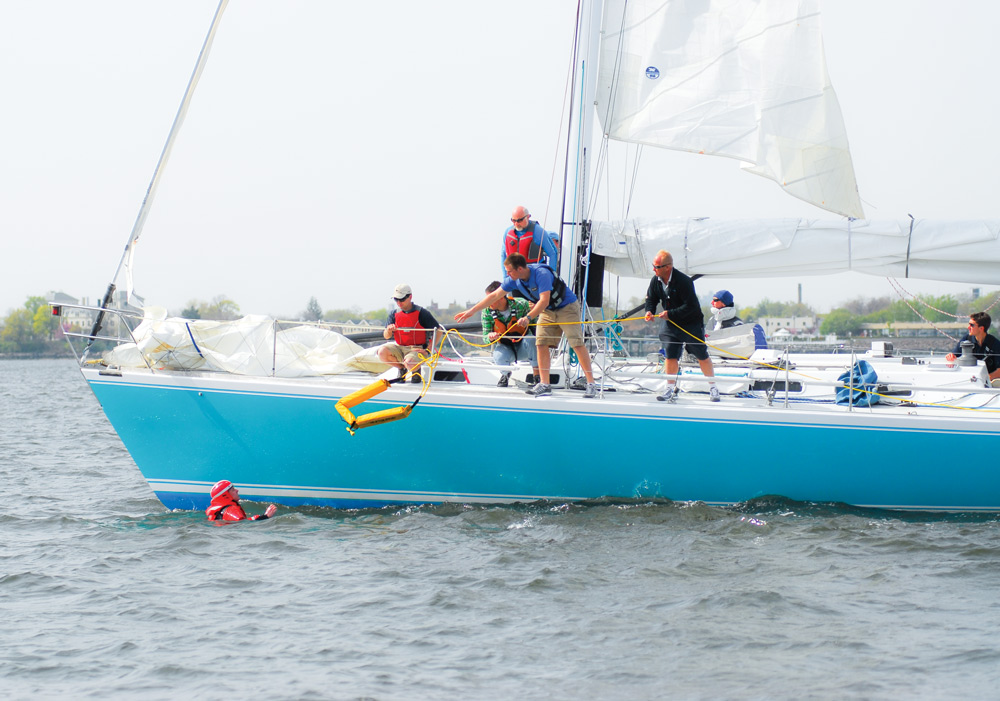Survive going overboard
You’re in charge of your own survival when you go overboard and are waiting for rescue
Imagine this scenario: You’re in the water looking at the stern of your 42-foot sloop as it sails away from you, cries of “Man Overboard” coming from a couple of the crew, and the billowing spinnaker getting smaller at a rapid pace. You take some comfort knowing that your crew has practiced overboard drills using a bucket and a fender, even with the spinnaker flying, and that you know they saw you go over the side.

So what are your priorities as you await the return of your boat and crew? They break down into some broad categories:
1. Don’t drown.
Investigations of overboard incidents frequently find that the PIW (person in water) drowned remarkably quickly, sometimes before the boat could return to the PIW. This is especially true in very cold water (less than 50 degrees) if the PIW gasps upon immersion (the gasp reflex.) If the PIW’s head is underwater when the gasp occurs, water can enter the lungs resulting in coughing and gagging, and the start of drowning. A life jacket, especially one with greater than minimum buoyancy, can get you back on the surface so that you can “maintain an airway” by keeping your mouth above the water surface. Immersion in cold water also causes very rapid breathing, perhaps 40 times per minute, which may cause the PIW to aspirate water because they lack the ability to coordinate their breathing with the waves.
The clothing that you’re wearing can also have a positive effect on preventing drowning. A foul weather gear jacket that’s zipped up and relatively tight around your neck will capture a lot of air and provide extra buoyancy until the air leaks out. In Safety at Sea courses, some students don’t immerse deeply enough when jumping into the pool to activate their water-activated inflatable life jackets due to the temporary buoyancy caused by air in their jackets.
This is a good time to mention the benefit of having leg straps on your life jacket, especially high buoyancy inflatables models. The ability to keep the life jacket low on your torso, immersed in the water, forces you head farther out of the water (greater freeboard), thus making it easier to avoid aspirating water.
2. Conserve heat.
The cold water will continually extract heat from your body as long as you’re immersed, and even after you’re back on board if you don’t get out of your cold, wet clothing. Your goal is to reduce cold, moving water from passing over your high heat loss areas: head, neck, axillary and groin. The Heat Escape Lessening Posture, or HELP, can halve the rate at which your body loses heat.
To assume the HELP position cross your ankles and pull your knees to your chest to reduce water movement in your groin. Then clamp your upper arms against the sides of your chest—your axillary area—to reduce water flow in this low-fat, high blood flow area. Grasp your life jacket or knees with your hands. Then focus on staying calm in this fetal position to retain your body’s heat.
A limitation with HELP position is that it only works if you have an inflatable or high buoyancy (more than 35 pounds of buoyancy) inherently-buoyant life jacket on. With a dinghy-style vest, there’s not enough buoyancy to keep your body stable and your face out of the water, and the tendency is to roll over. In that case, concentrate on reducing your movement in the water. Don’t swim unless safety is a very short distance away, and don’t make unnecessary movements with your arms and legs.
3. Make yourself more obvious.
You should be carrying a few items in your foul weather gear jacket, or bum bag, that will help your crew (or the Coast Guard) to find you. During the day, a mirror is really effective, but takes some practice to aim it correctly, and you have to be able to see your searchers for it to be effective. At night, either a strobe or a continuous LED light are really effective and without them, you are far less likely to be found. In testing on San Francisco Bay at night, observers liked the strobe lights when looking for someone at a distance, but greatly preferred a steady light when closing in on the PIW.
One of the items with the greatest return on investment is a whistle. For a few dollars, you can get a shrill whistle that requires much less energy than shouting, and is more distinctive. In the WingNuts incident in 2011, when six crew of a Kiwi 35 that capsized in the Chicago-Mackinac Race were rescued, the use of whistles by the crewmembers was credited with helping their rescuers to be alerted to their position.
4. Tell everyone where you are.
How do you do this? With one of the several Personal AIS Beacons (PABs) which transmit an AIS signal to vessels in your vicinity, and in some models, a Digital Selective Calling signal. These marvels combine a GPS receiver, an AIS/VHF transmitter, and a strobe light in a package not much bigger than a magic marker or pack of playing cards. The exact position of the PIW is updated frequently, so it’s more effective than a single Man Overboard waypoint that might be marking the original and wrong location as the PIW drifts.
5. Avoid the entire situation.

The Safety and Seamanship Committee of the Cruising Club of America has recently published their recommendation for use of life jackets and harnesses, and it’s available here: https://cruisingclub.org/article/recommend-jackets
Falling overboard from auxiliary sailboats accounted for only half of the 12 fatalities from such boats compared to 636 total recreational boating fatalities in 2022. These deaths are largely preventable through the use of good practices, and survivable with the proper personal gear. Wearing a life jacket, using a harness and tether in certain situations, and practicing maneuvers with your crew can greatly reduce the risk of being an overboard fatality.

Comments